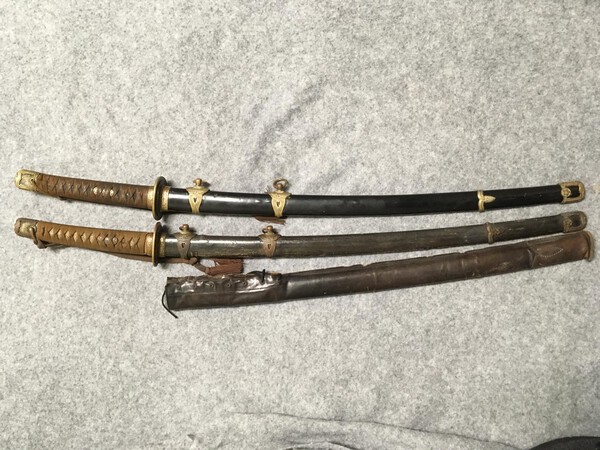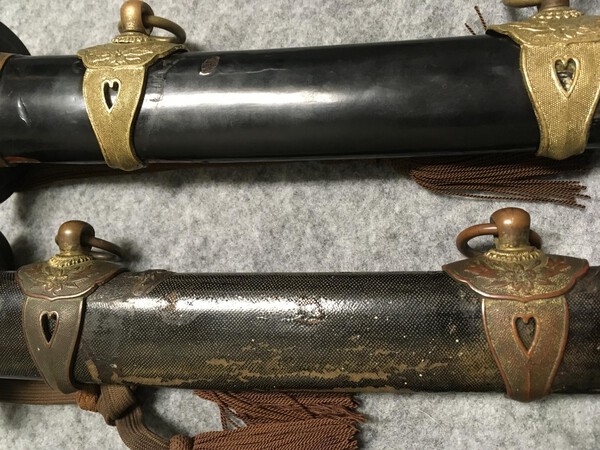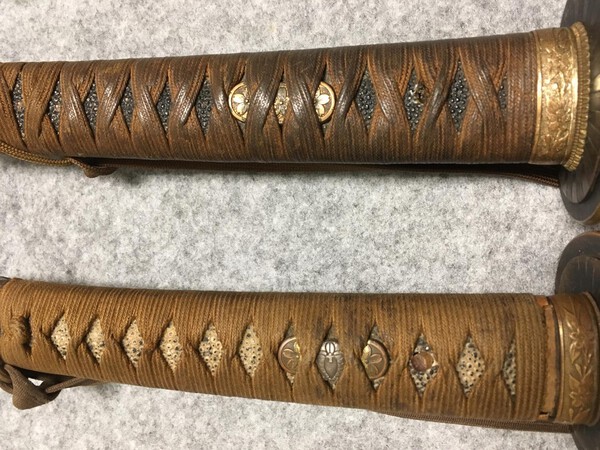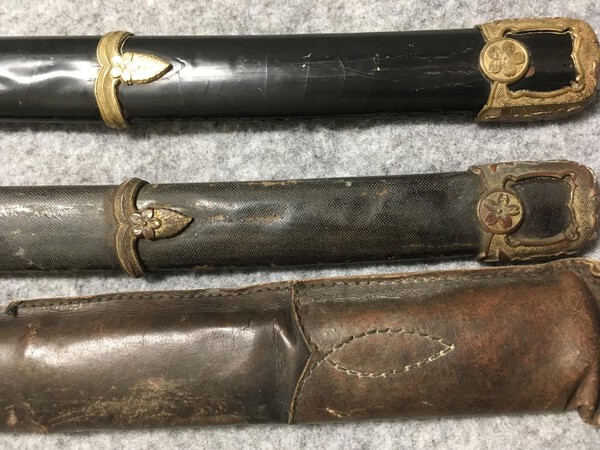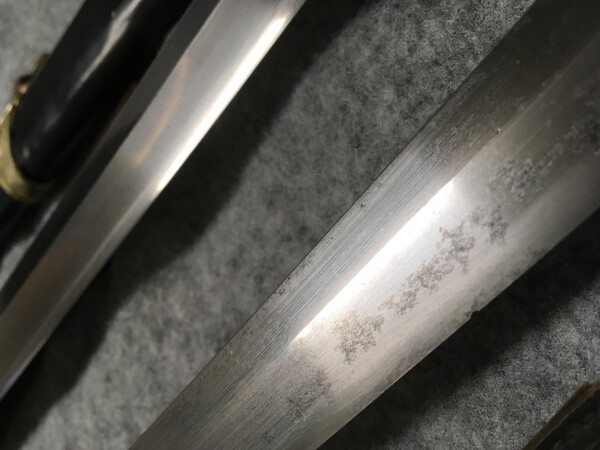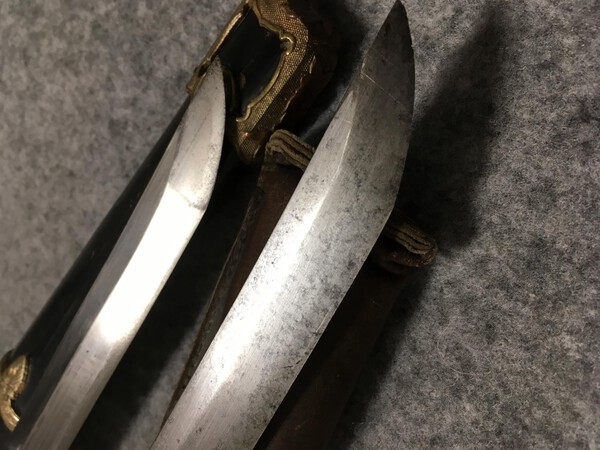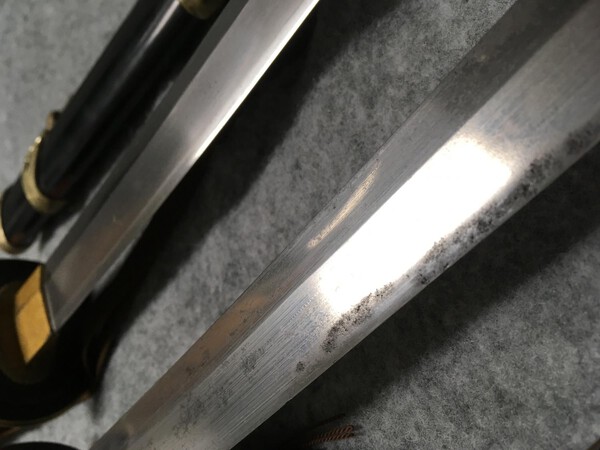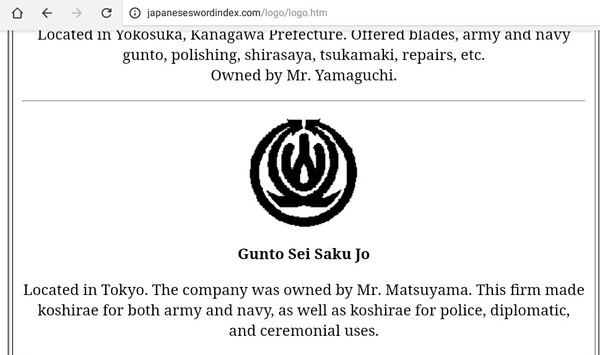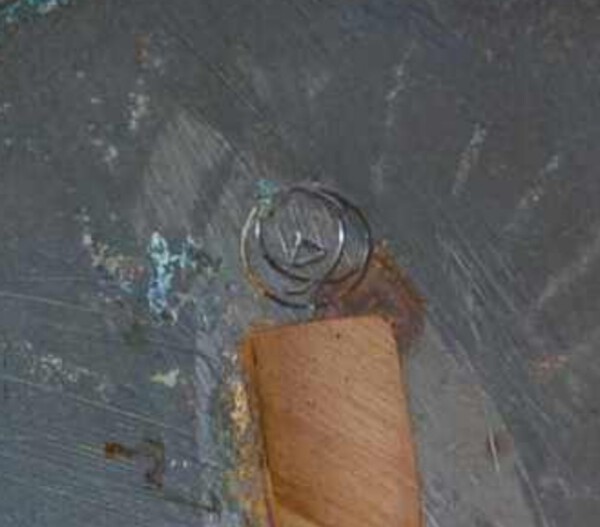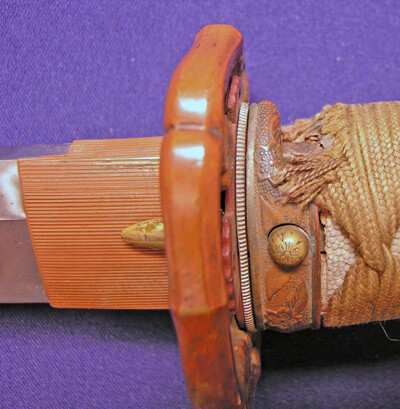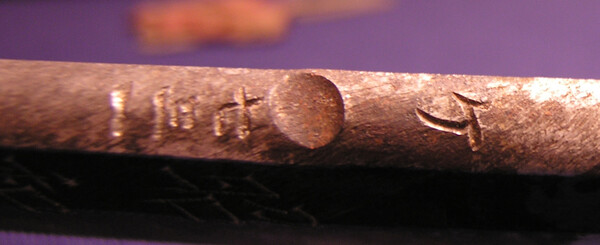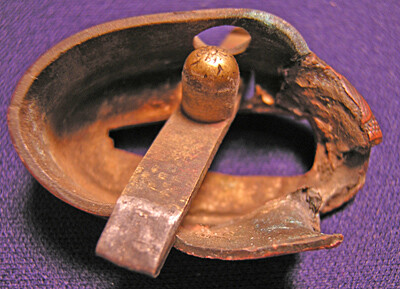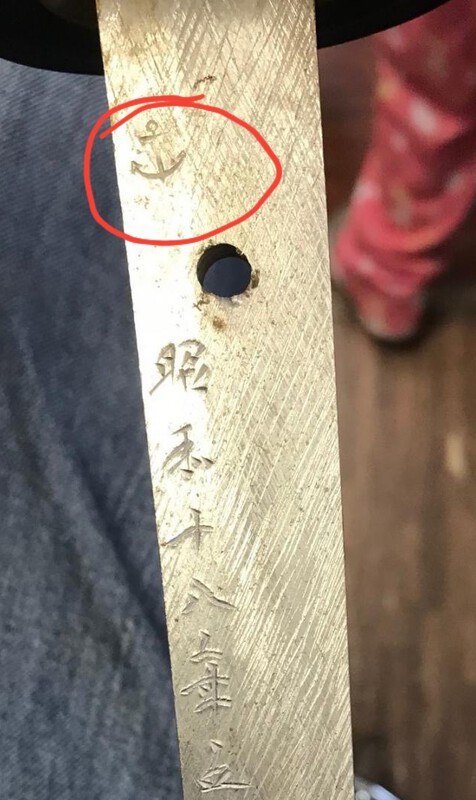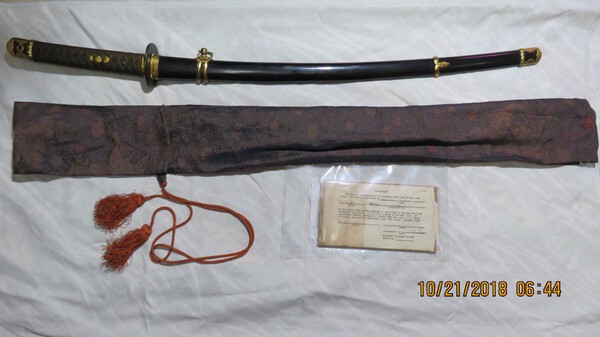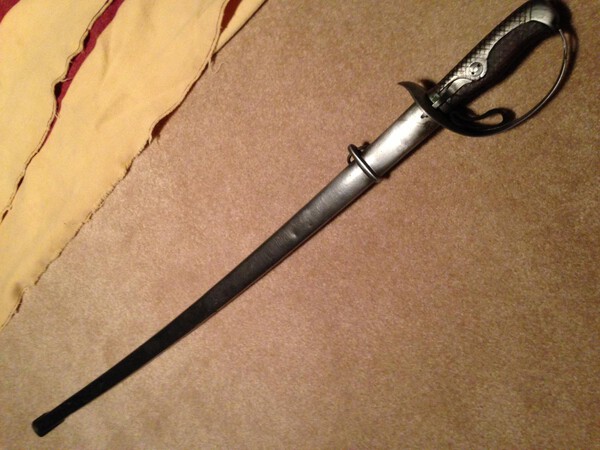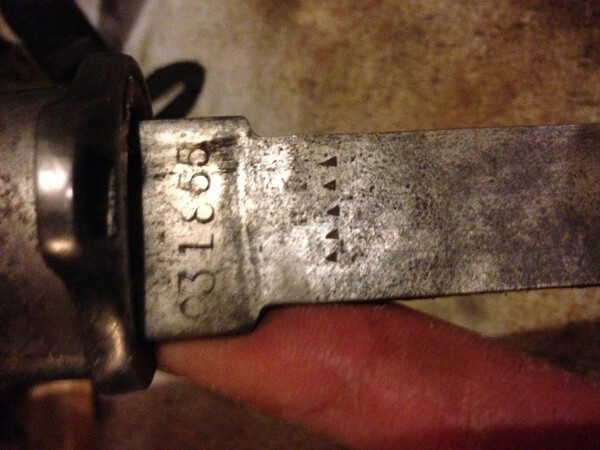-
Posts
13,764 -
Joined
-
Last visited
-
Days Won
169
Content Type
Profiles
Forums
Events
Store
Downloads
Gallery
Everything posted by Bruce Pennington
-

Tale Of Two Mantetsu Swords
Bruce Pennington replied to PNSSHOGUN's topic in Military Swords of Japan
Steve, I don't think John is just talking Mantetsu - it's the comparison of any two of a type. John, Here's 2 Navy gunto. One almost pristine, lived the easy life obviously! The other with combat leather, shows considerable wear to the sharkskin-covered saya, all the gilding is worn away, the black laquer of the same' is worn off. Additionally, the blade is a 4-600 yr old family blade that has a reshaped kissaki, a nick in the edge and centuries of aging. -
The stamp on your tsuba (hand guard) is of the Gunto Sei Sako Co, who made the fittings for the blade:
-

Nlf Gunto Discussion
Bruce Pennington replied to Bruce Pennington's topic in Military Swords of Japan
And another counter document from a discussion at Gunboards: It tells how permission to bring back war trophies was terminated in 1946. So, with this in mind, it is clear why the PX certificate was worded the way it was - regardless of the true origin of the gunto. On this fact alone, the 1950 document doesn't really tell us the facts we are looking for. I still think it is telling that the PX was selling them, and in 1950. To me, 5 years after the war was over, this indicates that brand new swords were being made and the PX was involved in the sales -
Yes, Didier, the top one is an enlisted man holding an officer gunto with an NCO tassel. He is an officer candidate. The bottom one seems to be a sgt holding a Type 95, NCO tassel, but I cannot see the bohi on the blade, unless it's just obscured by the shadow. The kissaki looks too long for a 95 though.
-
One side is often fatter than the other. Plus the wrap is covering, most likely, the fat end. Just have to try both sides. Sometimes I’ve had to grab the peg with small pliers. It just bamboo, if damaged they’re easy to replace ($3).
-
I’m afraid this appears to be a fake. But it’s not a kaigunto, it’s pretending to be a Type 98 Officer gunto. They were making fakes before the war was even over, and many more right after the war. Many G.I.s got duped. Further confirmation can be had with pictures of the tang. Hope you didn’t pay much. I still have the bad fake I bought years ago.
-
Yes, and it adds evidence that this “style” or mix was possibly “normal.”
-

Japan Sword Company Swords - For The Us
Bruce Pennington replied to Peter Bleed's topic in Military Swords of Japan
It’s all part of the history of the era, so thanks for the pics Peter! -
Thanks Didier. Yes definitely a reproduction. And agree with Dave on the interchangeability of saya - sometimes. I tried it on my Type 95s and some would switch and some wouldn’t, and those blades are more standardized than Officer gunto. But even with officer gunto there were some basic overall specs on dimensions, so always a chance of getting a fit on a saya made for another blade.
-
With WWII gunto, all the above options are possible. I have learned to never say "never" or "always" with gunto. Didier, as the owner will have to decide where he thinks this one lies on the spectrum of options and customization. Dawson has pictures of NCO's carrying civilian swords, NCO gunto, and officer gunto (as officer candidates). I was trying to find my reference for the officer candidate issue. Dawson has a couple of pics of NCO's as officer candidates carrying both Kyu- and T98 gunto, with officer tassels, but I thought I had seen some with NCO tassels on officer gunto as well, but cannot find the reference. Although my mind might be melding in the NCO T95 with Officer tassel instead. Didier, if you want to post some close-ups of the tassel barrel and the stiching on the buckle area, we might be able to help with ID'ing it as reproduction or original.
-

Any Shin Gunto With "battle Scars"?
Bruce Pennington replied to PNSSHOGUN's topic in Military Swords of Japan
Here's a Mantetsu gunto with a bullet strike on the fuchi: https://japanesesword.com/archived-pages/2017/7/28/mantetsu-to-in-34-pattern-shin-gunto-mounts-hit-in-the-fuchi-by-bullet -

Can Someone Please Help Me Identify This?
Bruce Pennington replied to dominator315's topic in Military Swords of Japan
HA! I guess my head was somewhere else when I was looking at this! And the anchor is lightly stamped not showing all the detail, but it is Tenshozan. -

Can Someone Please Help Me Identify This?
Bruce Pennington replied to dominator315's topic in Military Swords of Japan
Can't help with the smith, but the date is 1945. Month is really messy, but I think it's "5", so, May. -

Nlf Gunto Discussion
Bruce Pennington replied to Bruce Pennington's topic in Military Swords of Japan
Significant find! One of these for sale that comes with it's bring-back certificate. It's written out by the 8th Army Exchange and says it's a souvenir not a war weapon. By all appearances, it was sold by the PX! I think these were being made as part of MacArthur's post-war effort to keep businesses running. You can see more of it on this thread: http://www.wehrmacht-awards.com/forums/showthread.php?t=984036 -

Looking For Translation Assistance On This Sword From Ww2
Bruce Pennington replied to Bob-K's topic in Translation Assistance
I’m thinking 清次 (Kiyotsugu), but I’m not good at the smith names! -

Showato Koshirae Manufacture?
Bruce Pennington replied to lambo35's topic in Military Swords of Japan
You can find the logo's and names of several of the contractors here: http://japaneseswordindex.com/logo/logo.htm -
Steve, Thanks for this continuing education. We really depend on you (and Stegel when he's around) as the residant experts on 95's! This is one of the most accurate reproductions I've seen. For all the reasons you listed, though, I would have rejected it as fake, but can see that a rookie could easily be duped by it. I'm curious about your comment on the bohi. In my limited experience, the Tokyo/Kokura bohi end in a shape that mirrors the kissaki, where the rounded ends seems to come from Nagoya contractors. Have you seen rounded bohi ends on Tokyo blades?
-
Ha! But I think you misspelled ‘Murcans’! . But I not a gud spellur.
-
Mine is 3.5 in or 9cm from the top.
-
-
Here's mine, Steve. Additionally, as you might image of me, I took the handle off and found what I believe to be a date stamped on several of the parts, including inside the backstrap. Using the dot as a seperation between the year and the month/day, it's 1918 January 21.
-
Steve, I have one very similar but I am in my car and will post pictures when I get home. No stamps on the hand guard, serial number beginning with zero, and restamped numbers on the drag. These blades often went to the factory for rehab. It was common to see filed off numbers on the drag and new numbers restamped. Pictures to follow.
-
This is discussed on several current threads, but relevant here, in case someone is only seeing this here: The mystery of the "W" stamp on Mantetsu blades may have been solved. Nick Komiya, on Warrelics, posted a document requiring the Dalian factory to supply 5,500 unfinished blades to the Tokyo 1st Arsenal. Se had already narrowed the source of the stamp to the Tokyo arsenal, and this would explain the stamp on some Mantetsu blades. Four of the 6 smiths with W stamps are also associated with the Tokyo area, so only 2 smiths, from Seki, have W's that seem unexplained.
-

Attention Mantetsu Owners: A Survey
Bruce Pennington replied to Bruce Pennington's topic in Military Swords of Japan
This has been discussed on other threads, but as this one is turning into All-things-Mantetsu, I'd like to add it here as well. Nick Komiya, on Warrelics, posted an order from 1944, requiring the Dalian Mantetsu factory to supply 5,500 unfinished blades to the Tokyo 1st Arsenal (in addition to their own quota of 6,500 finished blades!). Sporter90 ovserved that this probably accounts for the presence of the "W" stamp on some Mantetsu blades. He also proposed that the Ren and Nan stamps on some blades may mean that Dalian was supplying the Mukden and Nanman Arsenals with blades too. I had been assuming (there's that dangerous word!) that Mukden/Nanman had simply been placed over Dalian as quality control inspectors, but it wouldn't make sense that 2 arsenals had authority over a factory. So, I think Sporter's idea is more logical - Dalian was probably supplying unfinished blades to them as well. No documentation to prove that, though. found on page 4 of this thread: http://www.warrelics.eu/forum/Japanese-militaria/very-unusual-konan-essei-mantetsu-713654-4/



